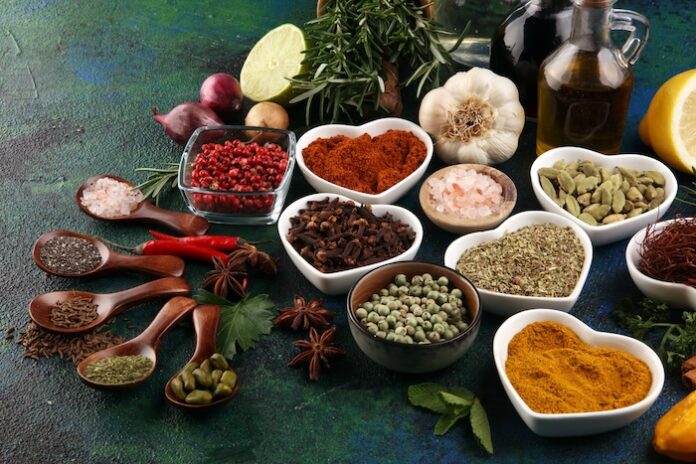Spice processing involves several stages, from cleaning and sorting to grinding, mixing, and packaging, all increasingly achieved with specialized machinery for optimizing efficiency, consistency, and the preservation of the spice’s aroma and flavor.
For cleaning and sorting, automated systems remove impurities like stones, dust, and other foreign materials. Air classifiers separate materials based on density, while magnetic separators remove metallic contaminants. Vibrating screens with AI-powered fault detection can further enhance sorting accuracy. Buhler Sortex machines are also used for spices, as well as for other food commodities such as lentils and rice.
While sunlight on smooth surfaces is used for drying spices, automated plants use hot air dryers, dehydration units, or fluidized bed dryers, which reduce moisture content to the desired levels and extend shelf life. Fluidized bed dryers are also used for even drying and moisture removal.
Spices are milled and ground into powders and granules using hammer mills, pin mills, and impact mills. Mills with variable speed drives allow the fine-tuning of particle sizes. Modern spice plants in India use cryogenic grinding to preserve the oils and aroma and for the superior retention of flavor over time. This method extends their shelf life in the supply chain and also at the customer’s end.
Automated mixing systems blend different spices to create custom blends, ensuring consistent flavor profiles. Pneumatic conveying systems transport spices between grinding and mixing stages. Recipe management systems are used for precise control over spice ratios.
On site testing labs are essential for quality control. Increasingly, automated camera-based devices monitor and inspect spices for defects throughout the process, and sieving machines generally ensure the final product meets the required quality standards. These are then conveyed hygienically into automated spice filling and sealing machines into various formats of containers to maintain freshness and quality, including pouches or bottles for retail and end-consumer use or in larger bags such as intermediate bulk containers.
Cryogenic spice grinding
Traditional grinding generates considerable heat through friction, which leads to the evaporation of volatile oils that give a spice’s characteristic flavors and aromas. Cryogenic grinding, operating at sub-zero temperatures (ranging from 0 to -196°C), minimizes heat-induced degradation and prevents the loss of these volatile components leading to a more intense and authentic flavor in culinary applications.
Rapidly freezing the spices to make them brittle allows for more efficient grinding and the production of finer, more consistent powders for better dispersal and flavor release when used in food preparation and cooking. For spices with high oil or fat content (like nutmeg), conventional grinding can lead to clumping and clogging of machinery. Cryogenic grinding solidifies these oils, preventing clumping and allowing for a smoother grinding process.
The use of an inert atmosphere such as nitrogen gas during grinding further reduces the oxidation of spice oils, contributing to increased stability and preventing rancidity. Apart from overall efficiency and the ability to achieve fine particle sizes, cryogenic grinding can make spice particles suitable for instant mixes, pharma ingredients, and herbal medicines.
The gases primarily used in the cryogenic grinding of spices are liquid nitrogen (LN₂) and, to a lesser extent, carbon dioxide (CO₂) in its solid form (dry ice). LN₂ has a boiling point of -196°C (-321°F), making it an extremely efficient cooling agent.
LN₂ displaces oxygen, reducing oxidation and preventing rancidity, thus increasing the shelf life of the spices, and by making the grinding chamber inert, it significantly reduces the risk of dust explosions, which can be a concern with conventional grinding. While not as cold as LN₂, CO₂ in its solid form (dry ice) can also be used to cool spices, making them brittle to create an inert atmosphere for reducing oxidation and preserving spice quality.
Low-temperature grinding minimizes the degradation of heat-sensitive components, such as antioxidants, vitamins, and essential oils, which contribute to the spice’s health benefits. Also, by avoiding excessive heat, bioactive compounds like curcumin in turmeric, capsaicin in chili peppers, and various antioxidants found in cinnamon, cardamom, and cloves, maximizing their health-promoting properties are retained.
While the heat generated in conventional grinding can cause spices like turmeric and red chilies to lose their vibrant colors, cryogenic grinding helps preserve the natural color of spices, making them more visually appealing and increasing their marketability. In addition, the low temperatures inhibit microbiological growth, contributing to a longer shelf life for the ground spices, which means they are less prone to spoilage.
IndiFoodBev — authentic, impactful and influential
An English-language food and beverage processing and packaging industry B2B platform in print and web, IndiFoodBev is in its third year of publication. It is said that the Indian food and beverage industries represent approximately US$ 900 billion in revenues which implies more than 20% of the country’s GDP. Eliminating the wastage on the farmside can help to deliver more protein to a higher number of the population apart from generating sizable exports. The savings in soil, seeds, water, fertilizer, energy and ultimately food and nutrition could be the most immense contribution that country is poised to make to the moderation of climate change.
To improve your marketing and grow sales to the food and beverage processing and packaging industry, talk to us. Our research and consulting company IppStar [www.ippstar.org] can assess your potential and addressable markets in light of the competition. We can discuss marketing, communication, and sales strategies for market entry and growth.
Suppliers and service providers with a strategy and budget for targeted marketing can discuss using our hybrid print, web, video, and social media channels to create brand recognition linked to market relevance. Our technical writers are ready to meet you and your customers for content.
The second largest producer of fruit and vegetables in the world is continuously expanding processing capacities and delivery systems with appropriate innovative technologies. We cover product and consumer trends, nutrition, processing, research, equipment and packaging from farm to thali. Get our 2025 media kit and recalibrate your role in this dynamic market. Enhance your visibility and relevance to existing markets and turn potential customers into conversations. Ask for a sample copy of our bi-monthly in print or our weekly IndiFoodBev eZine each Wednesday.
For editorial info@ippgroup.in — for advertisement ads1@ippgroup.in and for subscriptions subscription@ippgroup.in
Naresh Khanna – 10 February 2025
Subscribe Now











